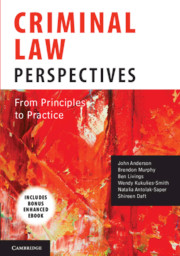Refine search
Actions for selected content:
36807 results in Cambridge Textbooks
Frontmatter
-
- Book:
- Principles of Integrated Marketing Communications
- Published online:
- 25 February 2021
- Print publication:
- 23 February 2021, pp i-iv
-
- Chapter
- Export citation
References
-
- Book:
- Crime Prevention
- Published online:
- 22 April 2021
- Print publication:
- 23 February 2021, pp 229-271
-
- Chapter
- Export citation
Index
-
- Book:
- Principles of Integrated Marketing Communications
- Published online:
- 25 February 2021
- Print publication:
- 23 February 2021, pp 496-508
-
- Chapter
- Export citation
Chapter 5 - Integrating digital and non-digital channels
-
- Book:
- Principles of Integrated Marketing Communications
- Published online:
- 25 February 2021
- Print publication:
- 23 February 2021, pp 149-196
-
- Chapter
- Export citation
Chapter 4 - Media planning for growth
-
- Book:
- Principles of Integrated Marketing Communications
- Published online:
- 25 February 2021
- Print publication:
- 23 February 2021, pp 108-148
-
- Chapter
- Export citation
About the author
-
- Book:
- Principles of Integrated Marketing Communications
- Published online:
- 25 February 2021
- Print publication:
- 23 February 2021, pp xvii-xvii
-
- Chapter
- Export citation
Chapter 12 - Advertising testing, campaign tracking and synergistic effects
-
- Book:
- Principles of Integrated Marketing Communications
- Published online:
- 25 February 2021
- Print publication:
- 23 February 2021, pp 431-476
-
- Chapter
- Export citation
Index
-
- Book:
- Crime Prevention
- Published online:
- 22 April 2021
- Print publication:
- 23 February 2021, pp 272-280
-
- Chapter
- Export citation
3 - Social prevention
- from Part 1 - Theory
-
- Book:
- Crime Prevention
- Published online:
- 22 April 2021
- Print publication:
- 23 February 2021, pp 35-54
-
- Chapter
- Export citation
9 - Preventing environmental crime
- from Part 2 - Practice
-
- Book:
- Crime Prevention
- Published online:
- 22 April 2021
- Print publication:
- 23 February 2021, pp 188-206
-
- Chapter
- Export citation
Contents
-
- Book:
- Crime Prevention
- Published online:
- 22 April 2021
- Print publication:
- 23 February 2021, pp vii-x
-
- Chapter
- Export citation
Chapter 11 - Direct response marketing and sales promotion integration
-
- Book:
- Principles of Integrated Marketing Communications
- Published online:
- 25 February 2021
- Print publication:
- 23 February 2021, pp 398-430
-
- Chapter
- Export citation
Preface and acknowledgements
-
- Book:
- Crime Prevention
- Published online:
- 22 April 2021
- Print publication:
- 23 February 2021, pp xi-xii
-
- Chapter
- Export citation
Chapter 9 - Public relations, corporate reputation, sponsorship, native advertising and content marketing
-
- Book:
- Principles of Integrated Marketing Communications
- Published online:
- 25 February 2021
- Print publication:
- 23 February 2021, pp 324-360
-
- Chapter
- Export citation
2 - Key approaches and frameworks
- from Part 1 - Theory
-
- Book:
- Crime Prevention
- Published online:
- 22 April 2021
- Print publication:
- 23 February 2021, pp 13-34
-
- Chapter
- Export citation
7 - Preventing violence
- from Part 2 - Practice
-
- Book:
- Crime Prevention
- Published online:
- 22 April 2021
- Print publication:
- 23 February 2021, pp 140-166
-
- Chapter
- Export citation
Dedication
-
- Book:
- Crime Prevention
- Published online:
- 22 April 2021
- Print publication:
- 23 February 2021, pp v-vi
-
- Chapter
- Export citation
Frontmatter
-
- Book:
- Crime Prevention
- Published online:
- 22 April 2021
- Print publication:
- 23 February 2021, pp i-iv
-
- Chapter
- Export citation
Chapter 2 - Uncovering insights
-
- Book:
- Principles of Integrated Marketing Communications
- Published online:
- 25 February 2021
- Print publication:
- 23 February 2021, pp 29-64
-
- Chapter
- Export citation

Criminal Law Perspectives
- From Principles to Practice
-
- Published online:
- 19 February 2021
- Print publication:
- 03 December 2020
-
- Textbook
- Export citation
